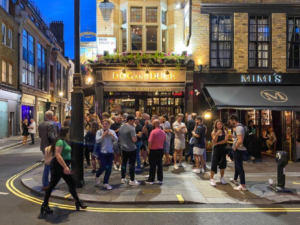Excavation by a church in the heart of Oxford finds strange layer with no sign of swine, and pots in which only kosher animals were cooked
Kashrut, the body of Jewish dietary laws, wasn’t born like Venus, neither fully formed and perfect nor from a clamshell. The rules evolved gradually over more than two thousand years and only took the shape familiar to today’s Jewry in early modern Europe. By the time of the medieval period in Europe, the practices were firm, leaving aside discrepancies in precise observances among the Jewish communities around the world such as whether chicken could be cooked in milk since they don’t lactate anyway.
Now, archaeologists from Bristol University report identifying two Jewish households in early medieval Oxford, based in large part on the missing oink.
Absent dedicatory plaques or Jewish symbols, identifying Jewish communities in archaeology starts with what isn’t there: a sign of the swine. In Israeli archaeological circles, ancient settlements are often categorized as “Jewish” or “other”: Canaanite, Philistine, etc. by the presence or absence of pig. It’s hardly categorical but there it is.
In the case of the study published Wednesday in the journal Archaeological and Anthropological Sciences, there was quite a wealth of evidence that two of the medieval homes discovered in a salvage excavation, done ahead of development works in central Oxford, were Jewish. Julie Dunne, the lead author on the study, confirms that no Jewish symbology was found in the site of the two house, but in fact, they were part of a Jewish neighborhood, as records indicate.
The first pogrom
When Jews first arrived in England is not known. Certainly Jews were in Europe, not only Palestine, since Roman times and likely before, but there is no record of Jewish communities or settlements in England before the year 1070.
The Jewish quarter in Oxford arose in the vicinity of St. Aldates Church some time after King William the Conqueror(1066-87) invited Jews in Rouen, northern France to move to England, the archaeologists explain. A pogrom in Rouen in 1096, which seems to have been the first such in Europe, by would-be crusaders may have accelerated Jewish migration to England.
Thereafter, Jewish communities arose in cities around the kingdom. Why William invited the Jews must remain speculative, but they could have been a convenient source of taxes when the king wanted them to pay for wars, for instance, the archaeologists suggest.
To be clear, the team of scientists, led by the University of Bristol with archaeologists from Oxford Archaeology, was digging up the heart of Oxford by St. Aldates Church as a salvage project because of planned development. It isn’t that they were necessarily looking for the lost Jewish quarter.
But, they had a clue they might find it, thanks to historic records going back that far and then some. The charmingly named Doomsday Book is effectively a census that was completed in 1086 at the order of the same King William.
Oxford has a relatively complete census record, street by street, house by house, going back a thousand years, Dunne explains.
This record for two addresses near St. Aldates Church 800 years ago show that one was a manse registered to “Jacob f. mag. Moses” and was called Jacob’s Hall. The other was a home belonging to “Elekin f. Bassina.”
It truly is to marvel that 800-year-old records show who lived where back then; what their names were; and then for the archaeologists to find the referenced residences, which they apparently did.
The Genesis precedent
The main surviving feature at the site was a latrine thought to be associated with Jacob’s Hall. It served both as toilet and trash dump. The archaeologists found a wealth of evidence from meals in this medieval loo. Aside from the obvious content, it contained remains from animals, all kosher: goats, sheep and cow; bones from an exceptional amount of chickens and geese; some bones of kosher-type fish such as herring – Dunne points out that fish bones, being delicate, don’t preserve well, but even so.
Two things were glaringly absent in one layer of the excavation: pig bones and hind legs.
The abhorrence of pigs needs no elaboration. The rear end thing is a bit more complicated. The biblical patriarch Jacob’s battle with a man reportedly representing God, at the place he would call Peniel, left him injured:
“The sun rose above him as he passed Peniel and he was limping because of his hip. Therefore to this day the Israelites do not eat the tendon attached to the socket of the hip, because the socket of Jacob’s hip was touched near the tendon” (Genesis 31-32).
This halakhic ban on eating hind legs can be circumvented by removing that “tendon,” the sciatic nerve tissue from the leg, which renders the hind leg kosher, explains Elon Gilad, Haaretz contributor and expert on Jewish history and language.
And that, in his view, makes the argument that the absence of a hind leg is indicative of a Jewish home in the early medieval period weak, because Jews have been working on circumventing the ban almost since it was written, he explains.
“The Talmud has a whole chapter that deals with the nerve in question,” Gilad elaborates. “When the Talmud was written is contentious, but it was definitely more than 800 years ago – probably in the years 500 to 600.”
Still, the evidence in contrast to other sections of the dig is compelling.
The Anglo-Saxon layer beneath the putative Jewish one shows they ate a lot of pork, and very few birds. So the bone assemblage in what appears to be Jacob Hall toilet suggests a Jewish dietary signature, now identified in British zooarchaeology for the first time, the team writes.
The clue of the residue
On top of the ancient records and the absence of pig remains and quadruped thigh bones, and the strange preponderance of birds – especially goose, molecular analysis of food residue inside clay pots found at the site revealed only kosher animals. Period.
“Evidence for pig processing was entirely absent,” Dunne tells Haaretz. If not for a constraint, they would have expected to find the common domesticates: goats, sheep, cows – and they did; some fish, and they did. But they found zero pig.
“Not finding any pig was unheard of,” Dunne adds. “We had never seen an assemblage like that in British archaeology though such assemblages had been found in Spain and Hungary, from the 15th century. So that told the archaeologists this looks like a Jewish community.”
Her contribution to the team effort was to analyze the organic residues in the ceramic vessels, which to be clear weren’t found in that latrine, but near it, in the same archaeological layer, she says.
You can’t do residue analysis on glazed pottery. But if its unglazed, the fats in food – that float on top of soup, for instance – get adsorbed into the clay matrix. “They literally permeate in,” she says. “Obviously pots are used time and again and the signal builds up over time. The structures of the lipids [fats] and isotope findings can determine what type of things were cooked. So we can identify if cattle, sheep, goat and pig were cooked – and milk.
And that is how they realized the pots in that layer had been used to cook sheep, goat and cow; zero pig; and zero milk either. However, one pot was found that gave a dairy signal – it had been used for milk.
She adds that little evidence of dairy processing has been found in medieval Oxford; perhaps cheese was prepared in farms outside the city and brought in.
And yes, if a pot is used for both milk and meat, we would see signals of both, she explains.
Other locals in Oxford 800 years ago did eat of the pig. Pottery residues and animal bones from a contemporaneous site at The Queen’s College, beyond the Jewish Quarter in Oxford, show it.
Jacob’s Hall seems to have been one of the wealthier homes in Oxford at the time. But the idyll, if such it was, wouldn’t last long. King Edward I expelled the Jews in 1290 and if any remained then, they worshipped surreptitiously. Jews would only be let back in by Oliver Cromwell, but not with a kiss, or even officially. It would only be in the 19th century that a law mandating special garb for Jews would be repealed.




